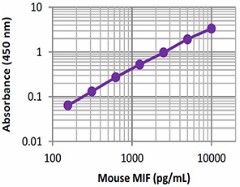- Regulatory Status
- RUO
- Other Names
- GIF, GLIF, MMIF
- Ave. Rating
- Submit a Review
- Product Citations
- publications

| Cat # | Size | Price | Quantity Check Availability | Save | ||
|---|---|---|---|---|---|---|
| 444107 | 1 Pre-coated Plate | $497 | ||||
Macrophage migration inhibitory factor (MIF), also known as glycosylation inhibiting factor (GIF), is a pituitary hormone and a macrophage- and T cell-derived cytokine that plays an important role in the endocrine and immune systems. MIF consists of 115 amino acids and has a molecular weight of 12.5 kD. Mouse MIF shares most of its identity with human (90%), rat (99%), and cattle (88%) MIFs, and a moderate percentage of its identity with MIFs from a wide variety of other species. It exists in monomeric, dimeric, and trimeric forms of identical protomers.
MIF is active as a pro-inflammatory regulator and upregulates multiple cytokines that are vital to combating infections in vivo, including tumor-necrosis factor (TNF), interferon-γ (IFN-γ), and interleukin-12 (IL-12). It is known to maintain cell survival and promote pro-inflammatory immune responses. MIF also activates the ERK1/ERK2 signaling pathway, which inhibits the immunosuppressive effects of glucocorticoids. MIF also plays a critical role in superantigen-induced toxic shock. It upregulates several factors that enhance the growth and invasiveness of gram-negative bacteria. MIF can enhance many inflammatory diseases, such as acute respiratory distress syndrome, arthritis, atopic dermatitis, allograft rejection, glomerulonephritis, inflammatory bowel diseases, asthma, and atherosclerosis. Known receptors for MIF include CXCR2, CXCR4, CD44, and CD74.
The LEGEND MAX™ Mouse MIF ELISA kit is a ready-to-use Sandwich Enzyme-Linked Immunosorbent Assay (ELISA) with a 96-well strip plate that is pre-coated with a rat monoclonal anti-mouse MIF antibody. The Detection Antibody is a biotinylated goat polyclonal anti-mouse MIF antibody. This assay is specifically designed to quantify mouse MIF from serum, plasma, cell culture supernatant, and cell lysate. This kit is analytically validated with prepared reagents.
Kit Contents
- Kit Contents
-
- Anti-Mouse MIF Pre-coated 96 well Strip Microplate
- Mouse MIF Detection Antibody
- Mouse MIF Standard
- Avidin-HRP
- Assay Buffer B
- Wash Buffer (20X)
- Substrate Solution F
- Stop Solution
- Plate Sealers
Product Details
- Verified Reactivity
- Mouse
- Application
-
ELISA
- Product Citations
-
- Sensitivity
- 25.28 ± 1.68 pg/mL
- Standard Range
- 156 - 10,000 pg/mL
- Materials Not Included
-
- Microplate reader able to measure absorbance at 450 nm
- Adjustable pipettes to measure volumes ranging from 1 µL to 1,000 µL
- Deionized water
- Wash bottle or automated microplate washer
- Log-Log graph paper or software for data analysis
- Tubes to prepare standard dilutions
- Timer
- Plate shaker
- Polypropylene vials
Antigen Details
- Biology Area
- Angiogenesis, Apoptosis/Tumor Suppressors/Cell Death, Cell Biology, Cell Cycle/DNA Replication, Immunology, Innate Immunity, Signal Transduction
- Molecular Family
- Cytokines/Chemokines
- Gene ID
- 17319 View all products for this Gene ID
- UniProt
- View information about MIF on UniProt.org
Related Pages & Pathways
Pages
Related FAQs
- In your LEGEND MAX™ ELISA Kits, there is a step that calls for washing the plates before adding sample. What is the purpose of this step?
-
We typically use a stabilizer for pre-coated plates. The additional washing step is designed to remove these components before you start the assay. If you do not perform the washing, the effect on assay performance is negligible.
- I have multiple LEGEND MAX™ ELISA kits that I want to run simultaneously. Can I use the same wash buffer for all the kits?
-
The wash buffer provided in all our LEGEND MAX™ kits is the same and the part numbers on the wash buffer bottles in these kits should be identical. For ELISA MAX™ Deluxe and ELISA MAX™ Standard Sets, we provide a recipe for the wash buffer on each kit’s technical data sheet. This recipe is the same for all ELISA MAX™ sets.
- For some of your ELISA kits, why do my serum samples require dilution with assay buffer?
-
In some cases, dilution with assay buffer is required to minimize the matrix difference between the samples and the standards to achieve better accuracy.
 Login/Register
Login/Register 












Follow Us